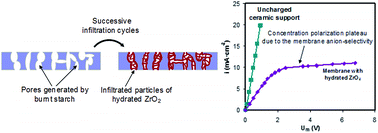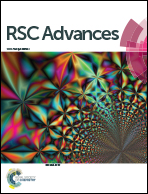Ceramic anion-exchange membranes based on microporous supports infiltrated with hydrated zirconium dioxide
Abstract
Anion-exchange membranes made from inexpensive ceramic materials were synthesized by using a simple procedure based on incorporating particles of an ion exchanger into a host microporous structure. Microporous ceramics produced from alumina and kaolin were used as supports, and their internal voids were functionalized by direct precipitation of hydrated ZrO2. The addition of starch as pore former to the sintering mixture induces the formation of pores within the micrometer range, where the subsequent deposition of hydrated ZrO2 occurred preferentially. An increase in the loading of hydrated ZrO2 particles improved the ion exchange capacity (IEC) and induced anion-selective properties on the membranes. However, when more than six infiltration cycles were performed, the membrane porosity was substantially reduced. Electrochemical measurements conducted in acidic and neutral media corroborated the implication of the hydrated ZrO2 particles on the development of concentration polarization and confirmed the strong relationship existing between the membrane porosity and electrical conductivity. Conversely, chronopotentiometric curves showed that the membranes practically lack of ion-exchange properties when tested under alkaline conditions. The methodology proposed to synthesize ceramic ion-conducting membranes could significantly broaden the utilization of electromembrane processes in industrial applications where the use of polymeric membranes is restricted due to their expensive cost or poor chemical stability.


 Please wait while we load your content...
Please wait while we load your content...